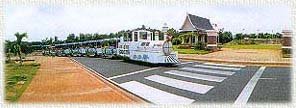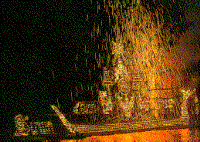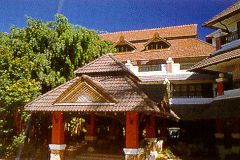
Monday, August 28, 2006
An interesting Khmer sanctuary, Prasat Phanom Wan is believed to have been built in the 10th century. During the 13th and 14th centuries, a stone building was built over it. From inscriptions found at the site, it is known that the sanctuary was used in the Hindu religion and later became a Buddhist site. Although most of it is in ruins, the layout of the structure that is still clearly visible includes a square main pagoda facing east and a  tiered pagoda in front, as well as a path linking the two structures.
tiered pagoda in front, as well as a path linking the two structures.
To the southwest of the main pagoda is a building of red sandstone called Prang Noi. Inside is a large stone Buddha image. A roofed sandstone walkway and a laterite wall surround the sanctuary. A Gopura (a sanctuary doorway or porch) in the form of a tall tower is situated in all 4 directions. Around 230 meters east of the sanctuary are traces of a moat and an earth hill that was the site of another Khmer building called Noen Oraphim.
Other Khmer ruins within Nakhon Ratchasima include Prasat Hin Nang Ram, Prang Ban Ku and Prang Sida all of which are similar to Phimai ruins but somewhat smaller.
This sanctuary is located in Ban Makha, Tambon Pho, around 15 kilometers from the city on the Nakhon Ratchasima-Khon Kaen Road. A sign on the right provides visitors with additional directions.
Nakhon Ratchasima Zoo
Covering an area of 545 rai (218 acres), the zoo is one of the most modern in Asia. The enclosures are large and landscaped by section to match the habitat of each animal most of which have come from Africa. The most popular animals are penguins, seals, African elephants, rhinoceros, cheetahs, lions, zebras, and giraffes. There is also a reptile building and a hornbill garden. In addition to being an ideal place to study biology, the zoo is a great place for relaxation as the grounds are decorated with lovely flowers. Other than the shuttle services that are provided to transport visitors around the zoo, there are bicycles available for rent. The zoo is open daily between 8.30 a.m. and 4.30 p.m. The fee is 10 baht for children, 30 baht for adults, and 30 baht for four-wheel vehicles. For information, call 0 4435 7355, 0 4421 6251-3 or visit http://www.zoothailand.org/.

The Zoo is located approximately 18 kilometers south of the city on Highway No. 304 (Nakhon Ratchasima-Pak Thong Chai), however, it is also accessible via Highway No. 2310 (approximately 1 kilometer drive). Visitors traveling by bus from the city can take air-conditioned bus No. 1415.
Read more!
Friday, August 25, 2006

ILLUMINATED BOAT PROCESSION
Date :02/10/2006 - 08/10/2006
Province : Nakhon Phanom,Thailand
Against the darkness of the moonlit night, the sight of flickering light from candles and lanterns on magnificent ‘fire boats’ drifting downstream on the Mekong River, is both mesmerising and awe-inspiring. It is this enchanting spectacle that has given the water-borne procession its very name -- ‘Lai Reua Fai', which literally means to set afloat a ‘fire boat’.
The illuminated boat procession is celebrated in I-San, the northeastern region of Thailand on the 15th day of the waxing moon to the first day of the waning moon in the 11th lunar month of the Buddhist calendar, usually a month earlier than the corresponding month in the conventional calendar. This dazzling event marks the end of the Buddhist Lent or ‘Ok pansa’ and is accompanied by a colourful street procession and cultural performances which add to the highlights of the event which is held annually.
Illuminated boats vary in shape and form and reflect cultural identity, artistic and cultural splendour, indigenous culture and beliefs, folk knowledge and skills. Designs inspired by Buddhist motifs, The Royal Barges, mythical characters in I-san and Brahmin legend and folklore are depicted. Naga – the Serpent King, Hong – the swan, the sacred steeds of the Brahmin gods – Hamsa, the sacred goose and mount of Brahma, Garuda – the mount of Phra Narai (Vishnu), Erawan – the mount of Indra and Ganesh – the elephant-headed son of Shiva are commonly featured.
 Origins of the Illuminated Boat Procession
Origins of the Illuminated Boat Procession
The Illuminated Boat Procession reflects Buddhist origins as well as animistic beliefs and the worship of the forces of nature.
According to some scholars, the ritual is based on ancient Buddhist tales and is undertaken to pay respect to the sacred footprint of the Lord Buddha on the bank of the mythical Nammadhammahantee river and in honour of the Buddhist trinity – Phra Buddha, Lord Buddha; Phra Dhamma – his teachings and Phra Sangkha – disciples of the Lord Buddha.
In his seventh lent, in remembrance of his mother, Buddha ascended to the heavens to deliver a sermon to his mother. There he resided throughout the entire period of the three-months Rains Retreat or the Buddhist Lent. At the end of the Rains Retreat which falls on the first day of the waning moon of the eleventh lunar month, Lord Buddha returned to earth, descending by the Celestial Stairway comprising of the Silver, Gold and Crystal stairs.

Delighted by the news of Buddha's return to earth once again, Buddha's disciples and followers prepared to receive him with offerings of food and other sacred items being presented. ‘Tak Bat Devo’, the Buddhist merit-making ritual performed on the final day of the festival signals the end of the Buddhist Lent, originates from the word "Devorohana" and refers to Buddhist celebrations marking the special occasion of the return of the Lord Buddha to earth, as mentioned in ancient Buddhist tales.
In traditional river-based communities which rely on the river as a source of food, harvesting fish and other marine life from the river and planting crops on the banks of the river in the dry season when the water level recedes, water is the essence of life. In riparian cultures, ritual offerings are made to Mae Khongkha - Mother of Waters in an act of appeasement to beg for her forgiveness for Man's carelessness in polluting pristine waters - the source of all life; The Naga – the mythical Serpent God associated with water that dwells in three realms: beneath the earth where it guards minerals and gems, in bodies of still and flowing water, and in the skies where it creates the rain which nourishes crops; and other celestial powers responsible for the gift of life revered by the I-San people. By setting the ‘fireboats’ adrift, one also symbolically casts away one's grief, misery and ill-fortunes.
Read more!
Wednesday, August 16, 2006
Wiang Kum Kam, the Underground ancient City In 1984, just outside the modern Chiang Mai metropolitan area, archaeologists uncovered the remains of an ancient city. Research concluded that this was the city of Wiang Kum Kam, one of many fortified cities built by King Mengrai as he consolidated his hold on the north. In fact, it appears that Mengrai may have lived at Wiang Kum Kam for a few years before Chiang Mai was constructed.
Nearly 20 temple sites have been uncovered in the area, which lies between the Ping river and the Lamphun highway. The buildings were buried underground by years of flooding, which apparently is the reason Mengrai eventually moved his capital to Chiang Mai. In fact, the
 Ping river originally flowed along the north side of the town, but at some point during the Burmese occupation from the sixteenth to eighteenth centuries, the river changed course and now flows along the west side of the site. The change of course was apparently the final straw which caused the city to be largely abandoned for 300 years. The site is too large to cover on foot. The best way to see it is to start at the still working temple of Wat Chedi Liam, and tour the site by bicycle, tram or pony carriage. The nine main sites taken in on a typical tour are not greatly interesting compared to many of Thailand's ancient sites. What does make the trip worthwhile is the gentle pace and scenery of the countryside viewed from the back of a carriage or on a bicycle.
Ping river originally flowed along the north side of the town, but at some point during the Burmese occupation from the sixteenth to eighteenth centuries, the river changed course and now flows along the west side of the site. The change of course was apparently the final straw which caused the city to be largely abandoned for 300 years. The site is too large to cover on foot. The best way to see it is to start at the still working temple of Wat Chedi Liam, and tour the site by bicycle, tram or pony carriage. The nine main sites taken in on a typical tour are not greatly interesting compared to many of Thailand's ancient sites. What does make the trip worthwhile is the gentle pace and scenery of the countryside viewed from the back of a carriage or on a bicycle.Although most of the sites are not much more than platforms and ruined chedis, there are two working temples in the area that date from the city's heyday at the end of the thirteenth century. One is your logical starting point, Wat Chedi Liam. The other, more vibrant temple is Wat Khan Tom (also known as Wat Chang Kum), where in fact the spirit of King Mengrai is said to still reside.
Wiang Kum Kam is situated in Tha Wang Tan, Sarapee District, outside Chiang Mai city about the 3-4 km on Chiang Mai – Lamphun Rd.
Open everyday 08.00-17.00
Tel: 0 5332 1523 / 5328 3981
Read more!
Tuesday, August 15, 2006
Phuket
Located approximately 862 kilometers south of Bangkok is Phuket, Thailand's largest island, which is often dubbed as the pearl of the Andaman, or the pearl of the south. Its natural resources- rocky peninsular, limestone cliffs, white powdery beaches, tranquil broad bays and tropical in-land forests contribute to making it the South's wealthiest, busiest, most visited and most popular island and province.
Phuket borders on Phang-nga Province to the north. The other 3 sides are encircled by the Andaman Sea the place where many of the best diving sites are located. The island is connected to Phang-nga Province by Sarasin Bridge and Thep Krasattri Bridge.
Staying on the island is easy, as there are only two seasons in a year - the rainy season (May to October) and the hot season (November to April). Visitors are not recommended to travel to Phuket between September and October as they are the wettest months. The best period for a visit, is from November to February, when it is possible to see the clear blue sky, feel the fresh sea breeze and marvel at the crystal clear water while lying on powdery, palm-fringed beaches. Average temperatures ranges between 23°C and 33°C.
Read more!
Friday, August 11, 2006
Anantara Golden Triangle Chaing Rai To Host Elephant Polo 2006
 This annual event, ranked as the 6th largest event on theThai tourism calendar has, for the past five years, taken place in the royal saeside town of Hua Hin, situated 220km south of the Thai capital Bangkok. The tournament was introducted to Thailand in 2001 by Anantara Vice-President, Chistopher Stafford and is a charitable event that raises money for the country's National Elephant Institute in Lampang , northern Thailand.
This annual event, ranked as the 6th largest event on theThai tourism calendar has, for the past five years, taken place in the royal saeside town of Hua Hin, situated 220km south of the Thai capital Bangkok. The tournament was introducted to Thailand in 2001 by Anantara Vice-President, Chistopher Stafford and is a charitable event that raises money for the country's National Elephant Institute in Lampang , northern Thailand.In just five years the King's Cup elephant Polo Tournament has gine from a small 2-day event with 6 teams into a week-long extravaganza, which in 2005 featured 16 teams from 3 continents encompassing 55 players from 15 countries. The event now attracts corporate sponrs, which include such global brands as American Express, Birtish Airways, Chivas Regal, Mercedes Benz and PricewaterhouseCoopers. In addition to the world's top horse polo players, the 2005 tournament saw the return oh Bernie fraser, New Zealand' s former world-ranking , All Blacks rugby players plus newcomers , Nick Farr Jones and Peter fitzsimmons from Australia's wallabies team.
"The growing interest each year is enormous,"Staford commented. "When we started it was more of a weeked knock-round than a tournament. Last years we had a waiting list of teams wanting to take part!"
Thai Elephant Conservation Centre: http://www.changthai.com.
Read more!
Wednesday, August 09, 2006
Ko Samui, Ko Pha-ngan and Ko Tao
 The numerous islands along the coast makes Surat Thani (often known as Surat in short) a perfect hideaway for vacationers from around the world. The ideal destination for many is the Penang-sized Ko Samui, Thailand's third largest island, and its neighbour Ko Pha-ngan a celebrated island that hosts the biggest beach full moon party. North of Ko Pha-ngan is Ko Tao, renowned for its excellent coral reefs. To top it all is the dazzling 250-square-kilometer Ang Thong Marine National Park, where a stunning archipelago awaits to greet visitors with their charming palm-fringed beaches, crystal clear water and colorful coral reefs. The best time to enjoy one of these islands to the fullest is from April November.
The numerous islands along the coast makes Surat Thani (often known as Surat in short) a perfect hideaway for vacationers from around the world. The ideal destination for many is the Penang-sized Ko Samui, Thailand's third largest island, and its neighbour Ko Pha-ngan a celebrated island that hosts the biggest beach full moon party. North of Ko Pha-ngan is Ko Tao, renowned for its excellent coral reefs. To top it all is the dazzling 250-square-kilometer Ang Thong Marine National Park, where a stunning archipelago awaits to greet visitors with their charming palm-fringed beaches, crystal clear water and colorful coral reefs. The best time to enjoy one of these islands to the fullest is from April November.Aloha Resort
128 Moo 3 Maret, Lamai Beach, Koh Samui
Suratthani 84310 Thailand

SPECIAL RATES FOR INTERNET USERS
Valid : Now to 31 October 2006
Single Room 3,000.-
Twin Room 3,000.-
-Above rate are inclusive ABF
-Nett Raes are inclusive of Service charge and Value Added Tax.
-All Rates are in Thai Baht.
Amari Palm Reef Resort
14/3 Moo 2 Chaweng Beach Road, Boput Koh Samui
, Suratthani 84320, Thailand
 SPECIAL RATES FOR INTERNET USERS
SPECIAL RATES FOR INTERNET USERSValid : Now to 31 October 2006
Superior Suite SGL: 4,920.++ TWN: 5,330.++
All the ++ Prices are subject to 10% Service charge and 7% Tax.
All Rates are in Baht.
Read more!
Thursday, August 03, 2006
Chiang Rai, the northernmost province of Thailand is about 785 kilometers north of Bangkok. Situated on the Kok River basin, Chiang Rai covers an area of approximately 11,678 square meters with an average elevation of 580 meters above sea level. The province, which is located within the renowned Golden Triangle area where Myanmar, Laos and Thailand converge, is also known as the gateway to Myanmar, Laos and Southern China.
Lychee Fair Festivals
Lychee Fair This is held annually in May. Celebrating the provinces tastiest fruit, this fair features agricultural displays and exhibitions, local handicrafts, folk entertainment and beauty contests.
Songkran Festival Traditional Thai New year celebrations are best seen at Chiang Saen where 4 nations (Thailand, Laos, China and Myanmar) compete in boat races on the Mekong River. Beauty contests and cultural shows are added attractions. The festival is annually held from April 16-18.
Read more!